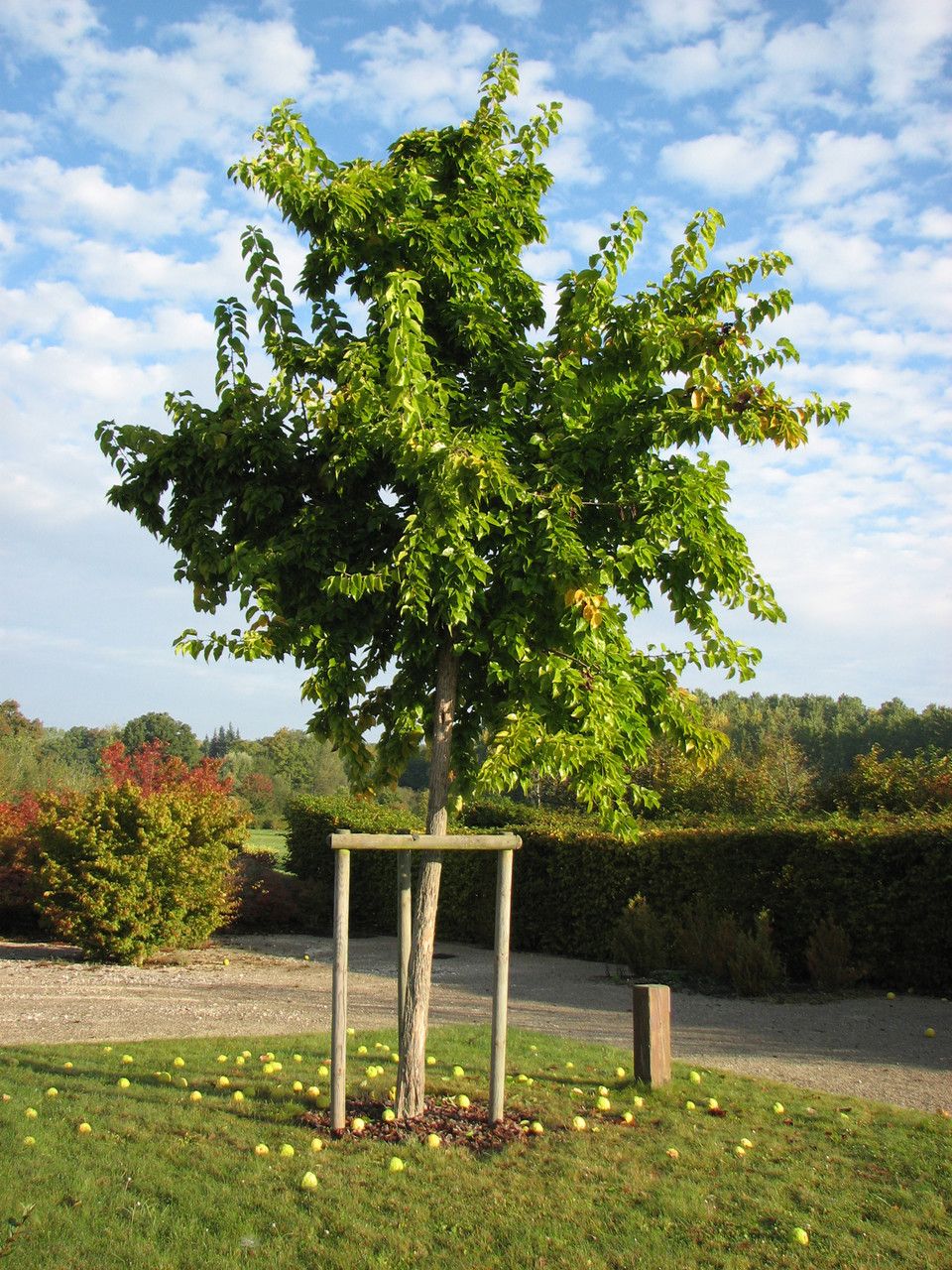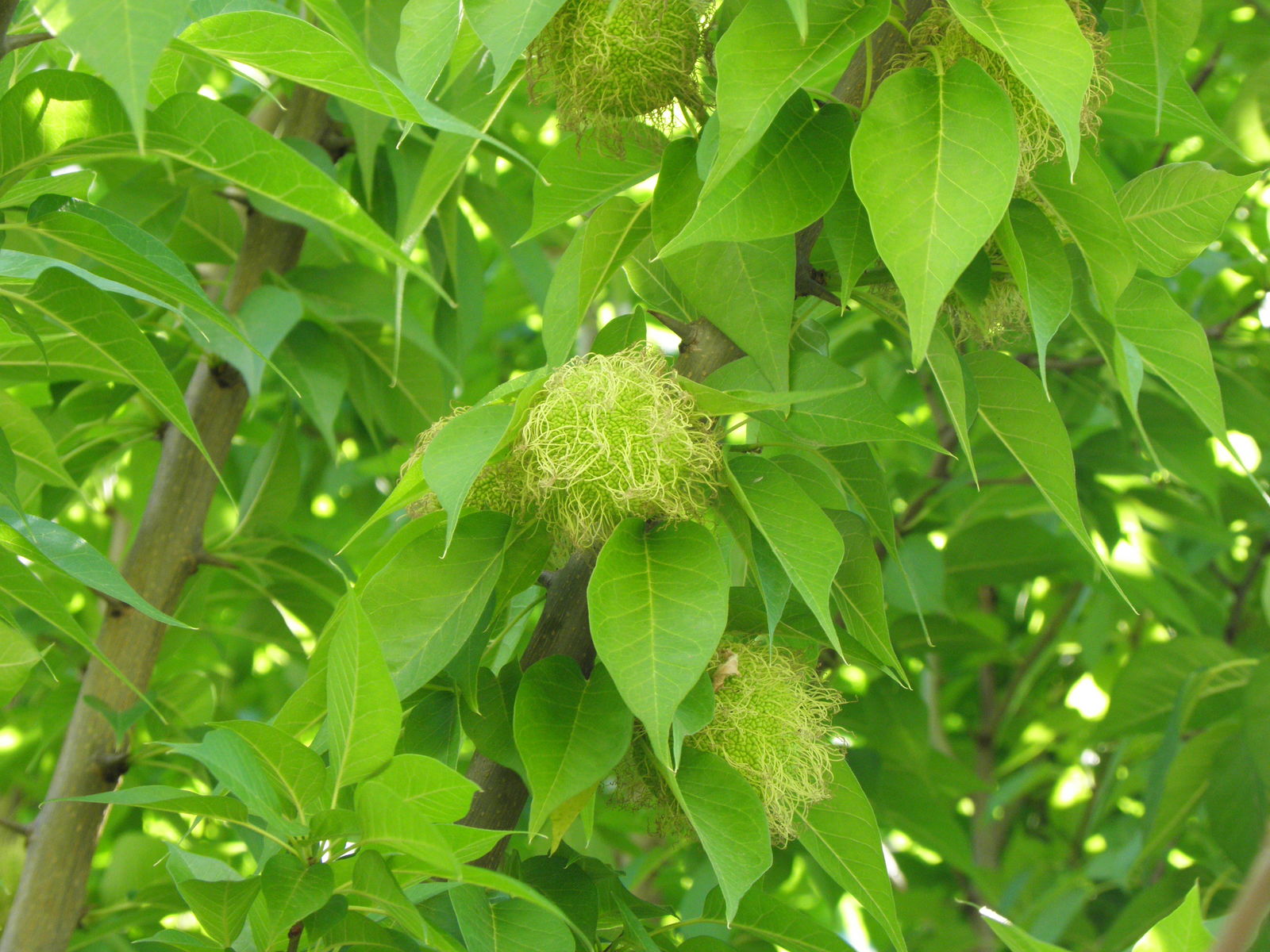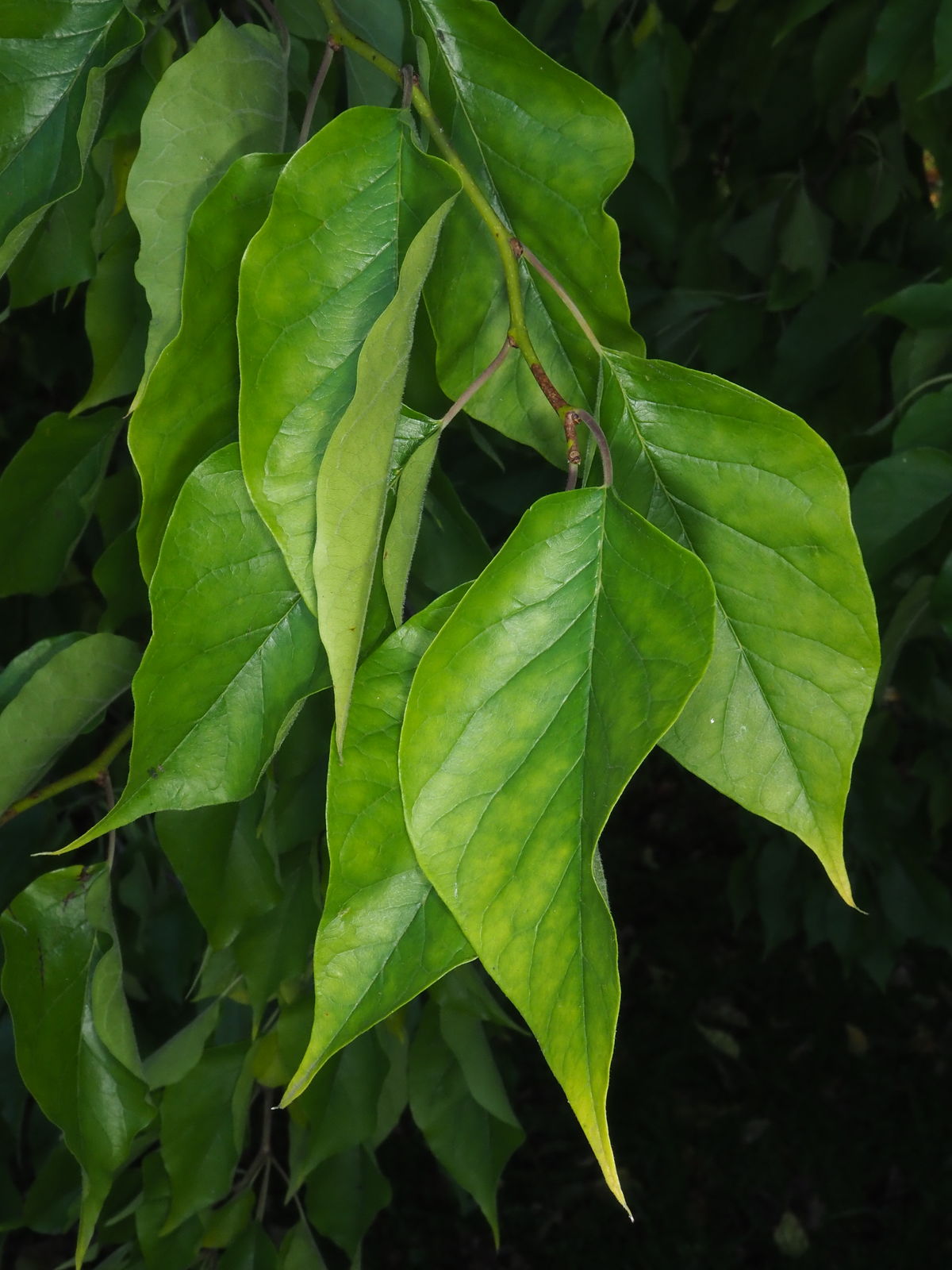Osage-orange
maclura pomifera
Also known as: ["Bois d'arc","Bow-wood","Hedge apple","Mock orange"]
Overview
A deciduous tree native to the southern United States, known for its large, spherical, bumpy fruit and extremely hard wood.
Benefits & Perks
["disease resistant","deer resistant","cold hardy","wildlife attractant (bees, butterflies, birds)","drought tolerant"]
Botanical Classification
| Phylum: | Magnoliophyta |
| Class: | Magnoliopsida |
| Order: | Rosales |
| Family: | Moraceae |
| Genus: | Maclura |
| Botanical Name: | Maclura pomifera |
Plant Characteristics
Basic Information
- Category: Trees
- Suitable Location: outdoor garden in open space with ample sunlight
- Suitable For:
- Is Weed: No
- Allergenicity: low
Environmental Needs
- Climate: {"temperatureRange":"–30 to 40°C"}
- Hardiness: {"zones":"4–8"}
- Misting: rarely required
- Drainage: Moderate to fast-draining; tolerates some clay but may suffer in waterlogged conditions.
- Soil Type: Adaptable to various soils but prefers well-draining, loamy soil with organic matter.
Maintenance Level
- Maintenance Level: moderate
- Toughness Level: high
- Pruning Frequency: Annually in late winter or early spring before new growth begins.
- Pruning Intensity: Moderate; remove up to 20–30% of old growth to rejuvenate the tree.
Care Details
Ideal Sunlight Coverage:
Full sun (6–8 hours of direct sunlight daily); tolerates partial shade but may produce fewer fruits.
Sunlight Tolerance Tips:
Acclimate new plants to full sun gradually over 1–2 weeks; protect from intense midday sun in hot climates; ensure outdoor placement in open areas for maximum light exposure.
Care Requirements
Care Difficulty
moderatemoderate
Sunlight
full sun
Rotate plant for even light exposure; use shade cloth in extreme heat; prune lower branches to allow light penetration.
Watering
every 2–3 weeks during active growth, less frequently in winter
Water thoroughly until runoff, ensure soil dries between waterings, and adjust frequency based on season and weather.
Soil
well-drained, loamy soil
pH: Adaptable pH range (6.0–7.5); tolerates slightly acidic to alkaline soils.
Mulch to retain moisture and suppress weeds; avoid compacting soil around roots; test pH if growth issues arise.
Temperature
Hardy in USDA zones 4–9; tolerates temperatures from -20°F to 100°F; prefers warm, temperate climates.
Protect from late spring frosts; water deeply before cold snaps; provide shade during heat waves.
Fertilizing
every 4–6 weeks during spring and summer with balanced fertilizer
Fertilize only if growth is poor; avoid high-nitrogen fertilizers; test soil before applying.
Propagation
Methods
Softwood cuttings in summer or seed propagation in autumn.
Step-by-Step Propagation Guide
- Take 4–6 inch cuttings, apply rooting hormone, plant in medium, maintain humidity.
- For seeds, clean, cold stratify, sow 1/2 inch deep.
Best Time: Summer for cuttings; autumn for seeds after fruit ripening.
Environment
Warm (70–80°F), humid (60–70%), partial shade for cuttings; cold stratification (30–60 days) for seeds.
Medium
Well-draining potting mix with perlite or sand; for seeds, use a mix of sand and peat.
Hormone
Rooting hormone recommended for cuttings to improve success rate.
Timeline
Cuttings root in 4–8 weeks; seeds germinate in 1–3 months with cold stratification.
Tools Needed
Pruners, rooting hormone, pots, misting spray, heating mat (optional).
Quick Tips
Use healthy, disease-free cuttings; maintain consistent moisture; protect seedlings from pests.
Pruning & Repotting
Pruning Guide
Method
Thinning cuts to remove entire branches back to the trunk or main branch; heading cuts to shorten branches.
Pruning Plan
Shape the tree, remove dead or crossing branches, and encourage fruit production by opening the canopy.
Tools
Pruning shears, loppers, saw (for larger branches), disinfectant.
Checklist
Disinfect tools, prune in dormancy, remove dead/diseased wood, thin crowded areas, shape the canopy.
Repotting Guide
Best Season
Early spring before active growth starts.
Pot Size
One size up (e.g., from 5-gallon to 7-gallon pot); increase by 2–3 inches in diameter.
Method
Remove plant gently, trim roots if necessary, place in a slightly larger pot with fresh soil, ensure good drainage.
Suggestions
Not typically repotted; if container-grown, repot every 2–3 years to refresh soil and accommodate growth.
Checklist
Check root bound status, trim roots if needed, use fresh soil, ensure drainage, water lightly after repotting.
Advanced Care Tips
Watering Mastery
Watering Checklist
Check soil moisture, water deeply, ensure drainage, adjust for season, avoid wetting leaves.
How to Apply Water Properly
Water directly at the root zone, apply until water drains from the bottom, ensure even saturation, and water early in the morning or late evening to minimize evaporation.
Watering Schedule Tips
Water deeply once per week during growing season; reduce frequency in winter to every 2–3 weeks, allowing soil to dry partially between waterings.
Soil Improvement
Add compost or well-rotted manure to improve fertility and structure; incorporate sand or perlite for drainage in heavy soils.
Temperature Stress Management
Signs of Temperature Issues
Chlorosis or leaf drop in extreme cold; wilting or scorching in excessive heat.
Cold Stress
Leaves may drop, growth slows, and young plants can suffer frost damage; mature trees are generally cold-hardy.
Solution: Mulch heavily around the base in winter; protect young trees with burlap screens; avoid planting in frost pockets.
Hot Stress
Leaves may wilt, scorch, or drop; fruit production may decrease; growth slows in prolonged heat.
Solution: Provide afternoon shade in extreme heat; water deeply and mulch to retain soil moisture; avoid fertilizing during heat waves.
Fertilizing Guide
Fertilizing Checklist
Check soil fertility, use balanced fertilizer, apply in spring, avoid late-season feeding, monitor growth response.
Fertilizing Method
Use balanced, slow-release fertilizer in early spring; avoid over-fertilizing, as it can reduce fruit production; reduce or stop fertilizing in late summer/autumn.
Common Problems & Solutions
Toxicity Warning
Cats
Slightly ToxicCats may experience mild gastrointestinal upset if they ingest the fruit of Maclura pomifera. The fruit's fibrous nature and irritants can lead to discomfort, but severe toxicity is rare. The milky sap may also cause mild skin irritation upon contact.
⚠️ Symptoms:
🌿 Toxic Parts:
⚡ Toxic If:
if eaten
Dogs
Slightly ToxicDogs may experience mild gastrointestinal upset if they consume the fruit of Maclura pomifera. The fruit's fibrous content and potential irritants can cause discomfort, but severe toxicity is unlikely. The milky sap may also cause mild skin irritation upon contact.
⚠️ Symptoms:
🌿 Toxic Parts:
⚡ Toxic If:
if eaten
Humans
Slightly ToxicThe fruit of Maclura pomifera, commonly known as Osage-orange, contains compounds that can cause mild gastrointestinal distress when ingested. The milky sap may also cause skin irritation in some individuals. Physiologically, the fruit is not highly toxic but can lead to discomfort due to its fibrous nature and potential irritants.
⚠️ Symptoms:
🌿 Toxic Parts:
⚡ Toxic If:
if eaten
Frequently Asked Questions
Q: Is the fruit of Maclura pomifera edible?
A: The fruit is not typically eaten by humans due to its tough, fibrous texture and lack of palatable flavor, though it is non-toxic.
Q: Why is the wood of Maclura pomifera so hard?
A: The wood is exceptionally dense and strong, historically used for making bows and tool handles due to its durability.
Q: Does Maclura pomifera attract wildlife?
A: Yes, it provides food and habitat for various wildlife, including birds and insects, though the fruit is not typically consumed by larger mammals.
Quick Reference
| Family: | Moraceae |
| Care: | moderate |
| Light: | full sun |
| Water: | every 2–3 weeks during activ |
Get Expert Care Tips
Download the Plantious app for personalized care reminders and plant identification!
Google Play App Store








